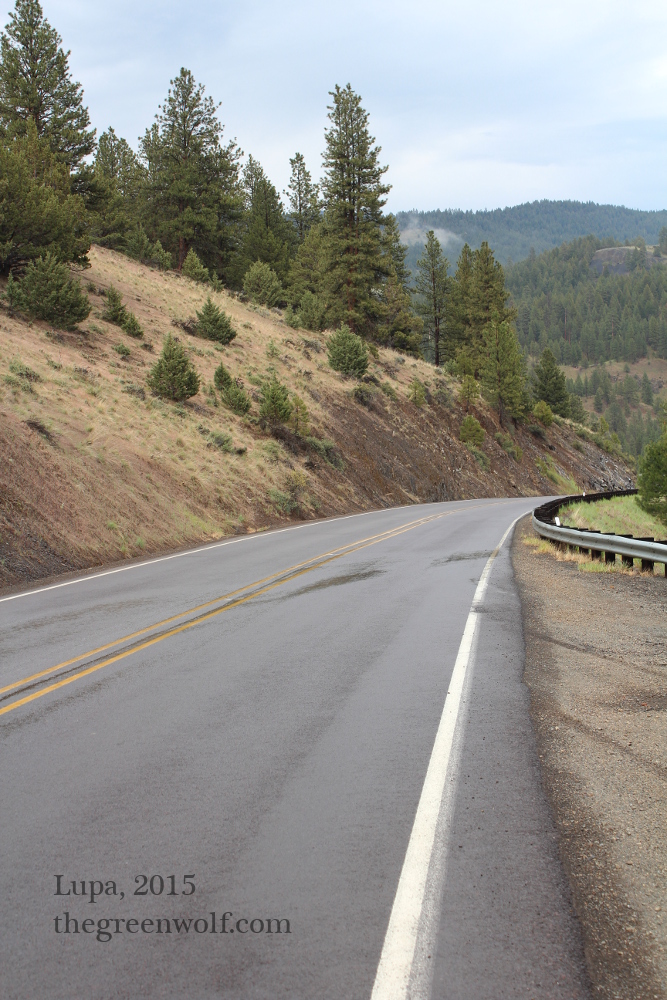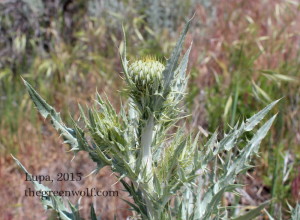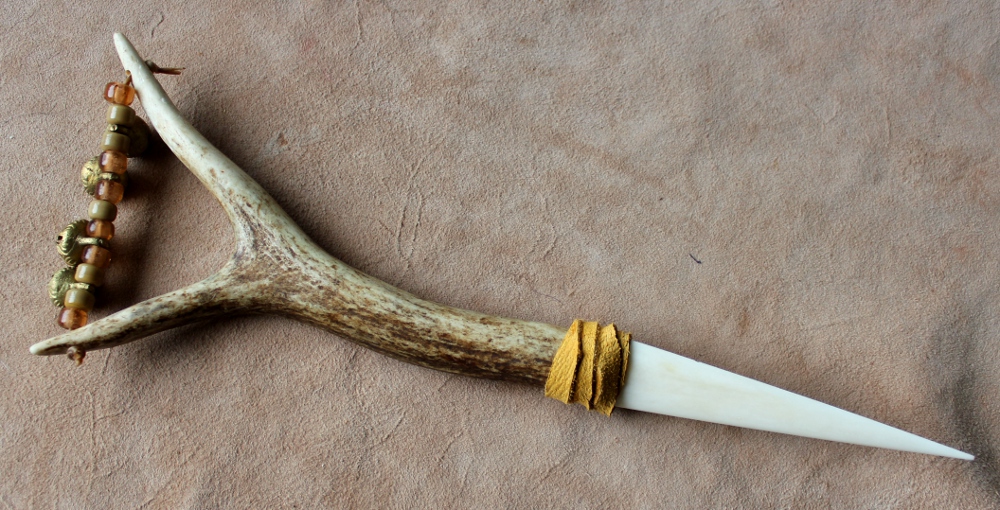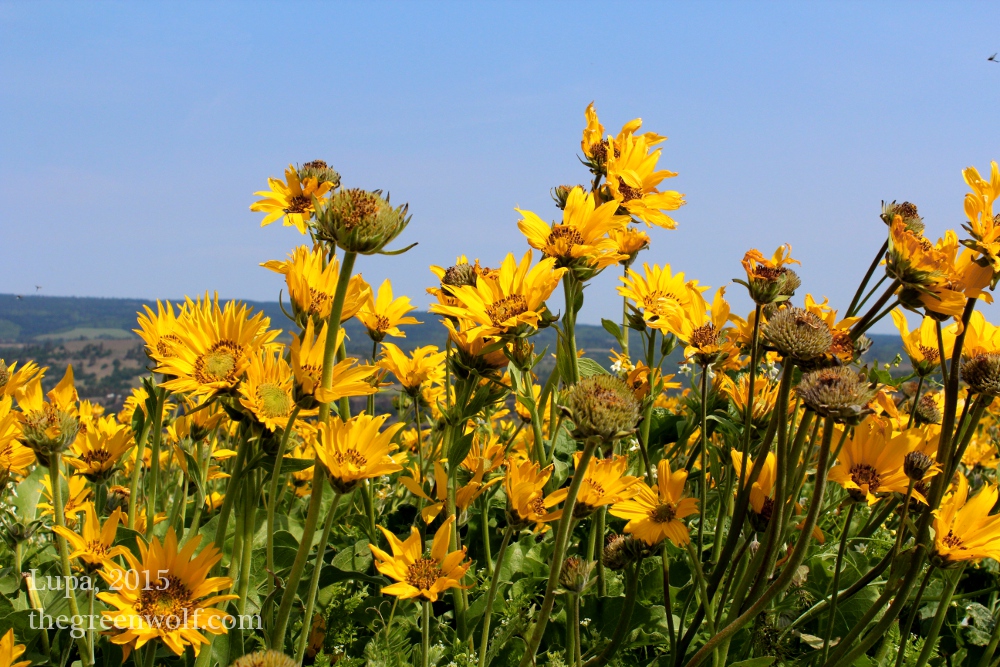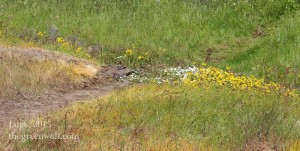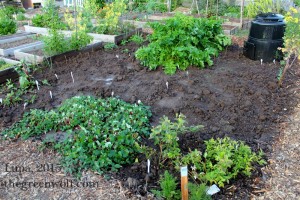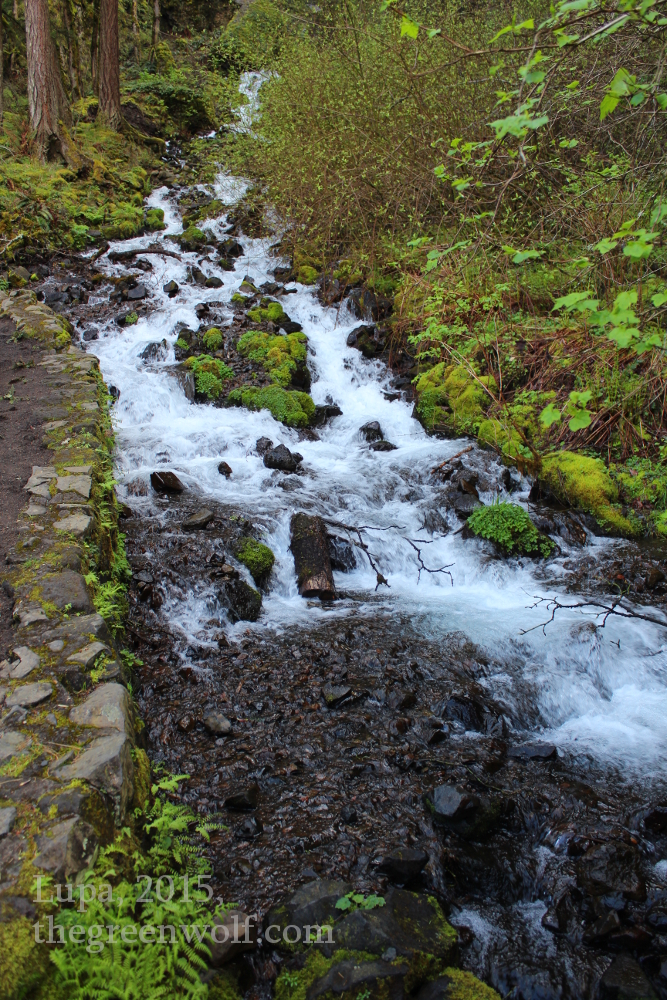Well, the trip isn’t delayed. But I’m wiped out. So I’ll report back with pics and stories later in the week when I’m home. For now–sleep, and then the final leg of my journey tomorrow.
All posts by lupa
Oregon Desert Adventures, Day 2
Time-Sensitive Note: The Tarot of Bones IndieGoGo ends in a week! If you haven’t yet backed it, you still have time to claim some awesome perks 🙂
Monday morning broke open with a haze of clouds and regret that I hadn’t brought my white noise machine with me. The hotel I was in was nice enough, but the neighbors were somewhat loud and someone decided to fall asleep with the TV on. I managed well enough with a white noise video on YouTube, but I miss my little cocoon of familiar static. Still, I got enough sleep to get up and going in the morning (with a quick trip by the continental breakfast).
My initial plan had been to head over to Boise and then come home by way of John Day. However, I found myself really disliking the idea of continuing down I-84 and wanted something more rural. So I dropped down 395 and headed south all day. My goal was to get to Steens Mountain on Tuesday, so my Monday was a leisurely wander from Pendleton down to Burns.
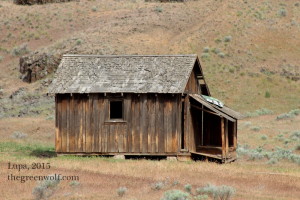 It was a day of many stops along the way to satiate my curiosity. When I was growing up, our family trips were all Point A to Point B with no stops in between, and only to go see family. I spent many hours wistfully looking out the window at signs advertising everything from tourist traps to state parks. Once I got out on my own I started making up for those missed opportunities, and these days even the heavily-laden trips to vending events often include stops at antique shops and the like.
It was a day of many stops along the way to satiate my curiosity. When I was growing up, our family trips were all Point A to Point B with no stops in between, and only to go see family. I spent many hours wistfully looking out the window at signs advertising everything from tourist traps to state parks. Once I got out on my own I started making up for those missed opportunities, and these days even the heavily-laden trips to vending events often include stops at antique shops and the like.
When unburdened, though, I’m like a dog with my nose to the ground–“Ooooh, what’s THIS, and now I want to go over THERE, and I think I’ll get going again except OOOOOH THIS SEEMS AWESOME!” And it’s soooo worth it. Today I discovered many treasures I would have missed otherwise if I was just driving to get from Point A to Point B.
I mean, no sooner was I out of Pendleton than I saw the sign for McKay Creek National Wildlife Refuge, and of course I had to go take a look. Since it’s post-migration there weren’t a ton of birds there, but there were some black-billed magpies with their flashy black and white coloration, and mourning doves cooing in the morning light, and California quail shuffling off into the grass. I made a note to come back later in the year when there would be more water birds. Not that the day was completely devoid: not even a mile south I pulled over on the side of the road and got out my binoculars to watch two dozen American white pelicans circling overhead on a lazy thermal–a spectacular addition to my birding life list! I also saw a hovering American kestrel and a red-tailed hawk along the roadside.
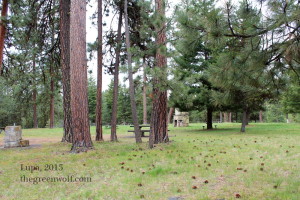 Driving down 395 is like an ecological layer cake. You mostly alternate between second and third growth Ponderosa pine forests, and scrubby sage and juniper deserts, with some farmland and pastures thrown in for good measure. It’s a truly fascinating experience because the shift from one biotope to another can literally happen as you turn a bend in the road. So it was that after miles of wheat and cattle, I found myself at a little campground on Battle Mountain, so named because it was the site of the last conflict between the Bannock tribe (who had retreated here from Idaho) and US troops, with some unwanted spillover onto the local Paiutes. I felt more comfortable here than at Celilo, in no small part because I was the only person in a field full of empty picnic tables.
Driving down 395 is like an ecological layer cake. You mostly alternate between second and third growth Ponderosa pine forests, and scrubby sage and juniper deserts, with some farmland and pastures thrown in for good measure. It’s a truly fascinating experience because the shift from one biotope to another can literally happen as you turn a bend in the road. So it was that after miles of wheat and cattle, I found myself at a little campground on Battle Mountain, so named because it was the site of the last conflict between the Bannock tribe (who had retreated here from Idaho) and US troops, with some unwanted spillover onto the local Paiutes. I felt more comfortable here than at Celilo, in no small part because I was the only person in a field full of empty picnic tables.
After lunch, I drove on, more than once pulling onto the shoulder to snap photos of falling-down old cabins. I made a brief foray into lovely Ukiah, OR (population 230), then tarried a bit longer in Fox, a near ghost town with a few old buildings, a beautiful 19th century church, and a lovely old cemetery. In fact, cemeteries were something of a theme; once I passed John Day and went into Canyon City, I had to go up and check out the graveyard there, including the old Boot Hill where two horse thieves and a pair of prostitutes, all from the old mining times, were buried apart from everyone else. The main cemetery was rather lovely, with some gorgeous old markers. I had to cut my visit short, though, as I could see rain rolling in across the land.
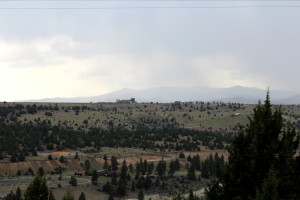 I did stop in old Canyon City where the buildings dated from the early 1900s. I took some pictures, then ducked into an antique shop where I bought some agate slabs and gabbed with the owner for a good hour or so; he’s a truly fascinating person who’s lived there for sixty years and has quite a lot of stories to tell. By the time I left it was getting late and the rain was beginning to fall harder, and I wanted to get to Burns at a reasonable time.
I did stop in old Canyon City where the buildings dated from the early 1900s. I took some pictures, then ducked into an antique shop where I bought some agate slabs and gabbed with the owner for a good hour or so; he’s a truly fascinating person who’s lived there for sixty years and has quite a lot of stories to tell. By the time I left it was getting late and the rain was beginning to fall harder, and I wanted to get to Burns at a reasonable time.
But there was just one more stop–as I drove down the highway, I saw a sign for Swick Old Growth Interpretive Trail. How could I pass that up? I’d outrun the rain a bit, so I decided to chance the weather. And it was worth it, for I found about a half mile loop of nicely paved trail with a series of informative signs about the old growth Ponderosa forest I was in. It was absolutely full of birds; I heard woodpeckers and mountain chickadees high up, and got some really good views of western bluebirds in the lower branches.
And now with a hotel room key and food all arranged, I’m relaxing from another lovely day. Tomorrow–Steens, and perhaps more!
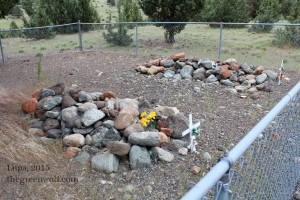
Oregon Desert Adventures, Day 1
So I’ve been planning to take a few days off for months now. 2015 has been an absolutely crazy year so far, and I haven’t had a proper retreat. I’ve been itching to get back out into the desert, so I decided to take a solo excursion for a few days on Oregon’s drier, less rainy side. My partner is holding the fort down back at home and making sure the garden doesn’t dry up, and for the next few days I’m free to roam!
This morning I headed out I-84; I’d never been further east than The Dalles, so this was going to be new territory for me. While I loved seeing the forests of the western part of the Cascades, I was relieved to see things shifting more toward Ponderosa pine than Douglas fir after Hood River, and in a few miles I could see the broken cliffs of basalt edging the Columbia River Gorge poking through the grasses.
 I stopped briefly at Celilo Park; this is the place where Celilo Falls was flooded when the Dalles Dam was completed in 1957. The nearby village of Celilo was the oldest continuously occupied location in North America until that point, with a 10,000+ year indigenous history, but it too was lost in the floods. This tragic history was in stark contrast to the park, where dozens of (mostly white) families camped and picnicked in apparent ignorance. I took a few photos, and then left, too sad to stay any longer.
I stopped briefly at Celilo Park; this is the place where Celilo Falls was flooded when the Dalles Dam was completed in 1957. The nearby village of Celilo was the oldest continuously occupied location in North America until that point, with a 10,000+ year indigenous history, but it too was lost in the floods. This tragic history was in stark contrast to the park, where dozens of (mostly white) families camped and picnicked in apparent ignorance. I took a few photos, and then left, too sad to stay any longer.
I then trekked up to Deschutes River State Park, where the Deschutes and the Columbia meet. Here was my opportunity to get some hiking in! There’s a system of trails that more or less parallels the Deschutes for several miles. I opted to start with the Upper Trail, which led me through sagebrush, wildflowers and grasses, and past the occasional willow tree. I saw several species of butterfly, scrub jays and ring-beaked gulls, and a young black-tailed deer bounded through the grass behind me.
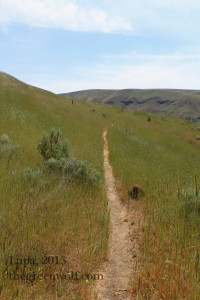 After about a mile and a half I headed downslope to the river again, and sat in the shade to eat my lunch. I watched the gulls skim over the water, and damselflies flitting back and forth. Then I decided to head back by way of the river trail–not such a great idea, as it was heavily overgrown with hemlock and Himalayan blackberry (and the occasional poison ivy). I cut back up to the sage brush as quickly as I could, and had a mostly unremarkable hike other than a sighting of a Western rattlesnake (at a safe distance).
After about a mile and a half I headed downslope to the river again, and sat in the shade to eat my lunch. I watched the gulls skim over the water, and damselflies flitting back and forth. Then I decided to head back by way of the river trail–not such a great idea, as it was heavily overgrown with hemlock and Himalayan blackberry (and the occasional poison ivy). I cut back up to the sage brush as quickly as I could, and had a mostly unremarkable hike other than a sighting of a Western rattlesnake (at a safe distance).
My hike complete, I drove on over to Pendleton past countless enormous windmills; I bid farewell to the Columbia around Hermiston. And now I sit ensconced in my hotel room, resting up and planning my adventures for tomorrow!
Plastics, Resins and Foams: On Trying to Be an Eco-Friendly Artist in an Era of Synthetics
“Hey, can you make me a pouch, but with fake fur instead of real?”
“I really like your animal headdresses, but can you make one with a taxidermy form and glass eyes in it?”
“Have you seen those resin rings with moss in them? I bet you could make an even better one!”
These are just a few of the suggestions I’ve gotten over the years as an artist. And I really do appreciate when people try to turn me on to new ideas, materials and the like. It shows that they’re paying attention to my work and they want to see what happens when I turn my creativity in a particular direction. (In other words: please don’t stop making suggestions just because of what I’m about to say in this post!)
Eco-Art and Styrofoam
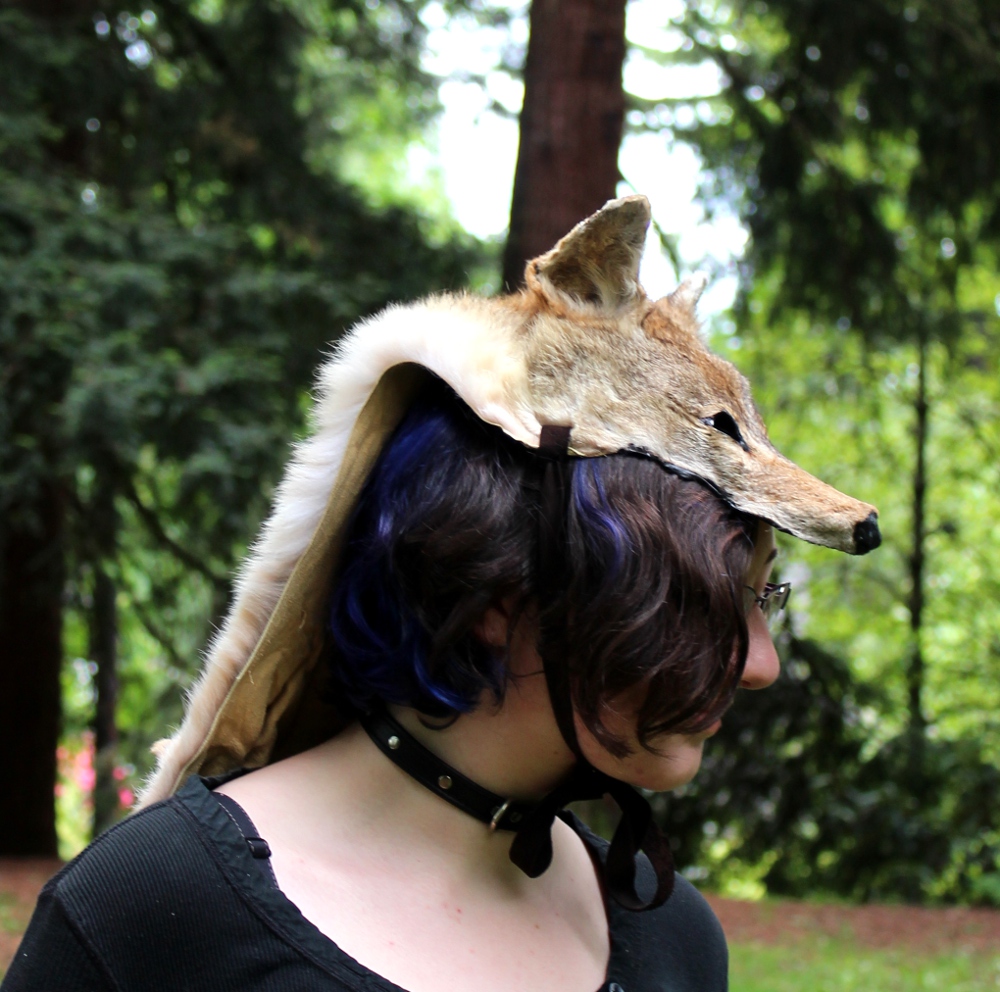 Some of these ideas work really well. Others…well…they don’t even get out of the starting gate. Some of them are axed due to the limitations of physics (real, triple-curled ram’s horns are very heavy and don’t work for the sort of headbands I use–and also my neck says ouch!) Others are no-go due to legalities (sorry, I can’t make you earrings with real raven/crow/hawk/blue jay/owl feathers since it’s illegal here.) And some, like the suggestions in the first paragraph of this post, I opt out of because I don’t feel they’re going to help me create more eco-friendly artwork.
Some of these ideas work really well. Others…well…they don’t even get out of the starting gate. Some of them are axed due to the limitations of physics (real, triple-curled ram’s horns are very heavy and don’t work for the sort of headbands I use–and also my neck says ouch!) Others are no-go due to legalities (sorry, I can’t make you earrings with real raven/crow/hawk/blue jay/owl feathers since it’s illegal here.) And some, like the suggestions in the first paragraph of this post, I opt out of because I don’t feel they’re going to help me create more eco-friendly artwork.
One of my biggest challenges as an artist and an environmentalist is finding eco-friendly art supplies. As with everything else in our industry-heavy society, most art supplies have been created solely with human need in mind; the environmental effects are much a much lower priority, except where regulations have induced manufacturers to comply with certain standards. Therefore our art supplies are full of plastics and other nonbiodegradables, along with a host of synthetic chemicals, unsustainably mined metals, and other environmentally unfriendly components.
So the very last thing I want to do is to add to that. I’ve had a LOT of people criticize my use of real fur and then suggest I use fake fur instead because it’s supposedly more “eco-friendly”. What they mean is no animal immediately died to make fake fur–but their fakes are made of plastic-based synthetic fibers. These plastics are often derived from petroleum, coal and other pollution-inducing materials, and the entire manufacturing chain for fake fur causes more animal (and plant and fungus) deaths than the death of a single fur-bearing animal. They also don’t biodegrade, and as they break up into ever-tinier bits of plastic they cause even greater pollution and destruction, up to and including killing zooplankton that eat the tiny fragments. (We need that plankton–it’s the backbone of the ocean ecosystem!)
The same thing goes for the polystyrene taxidermy forms on the market, and which people keep insisting I use for taxidermy headdresses. I am not about to take a brand-new chunk of non-biodegradable styrofoam and shove it into the head of a headdress, never mind the additional ecological burden of the hide paste (often polymer-based), plastic fake teeth, and mass-manufactured glass eyes used in the making of taxidermy. As for the resin jewelry? It’s made of acrylic, and I’ll explain why that’s a problem in a minute.
Allow me me make something clear: I’m far from innocent, even as I eschew the above suggestions. While I try to be mindful of my supplies, I’m as deeply embroiled in this system of toxicity as most other artists. Let’s look at a recent piece of mine as one example.
Deconstructing a Fox
This is a fox skull necklace I created earlier this year for an art show. It’s pretty typical of my work–lots of yarn and beads and paint, with real bone as the centerpiece. Pretty eco-friendly, right? Well, let’s dig into that a bit more.
The skull itself came from another artist’s leftovers; it was likely from an animal hunted or trapped for its hide. More people are reclaiming the bones from these animals so that more of the remains are being used rather than discarded. When other artists sell off their supplies or collections I like to buy them up when I’m able to afford to; it keeps me from having to buy new ones, and it lets me put a bit of money in the pocket of an individual who needs to pay the bills.
Bone itself is pretty environmentally neutral, but remember that in this case I coated it in acrylic paint. I use acrylic for all sorts of projects; it adheres well to both bone and leather, comes in a variety of colors, mixes easily and dries quickly. It’s durable enough to be put on drums (with sealant) and it’s inexpensive. It’s often upheld as a good alternative because it’s water-based rather than oil-based, and other than acrylics made with cadmium and other heavy metals they’re relatively free of pigments commonly thought to be toxic. But what about the acrylic itself?
Acrylic is a thermoplastic made from applying heat to certain organic compounds. At least one of which, acrylic acid, is very corrosive to human skin, so don’t think “organic” equals “harmless”! All an organic compound is is a molecular compound containing carbon–many of which can be man-made. Additionally, the craft-grade acrylics I usually use often have vinyl or polyvinyl acetate (in other words–more plastic) mixed in for better stickiness and to cut costs. Both acrylic and vinyl are polymers, which means they’re made of very long chains of molecules. It also means that they’re next to indestructible, and therefore not easily biodegradable. So essentially what this means is when I paint a skull with acrylic paints, I’m putting a very thin layer of plastic on it. Even if I forgo the acrylic sealant (which would add yet another layer or three of acrylic), it’s still a lot of plastic molecules that are eventually going to flake off into the environment, and even tiny bits of plastics can have a devastating ecological effect.
The skull is strung on a necklace made of braided yarn and embroidery thread. I did buy the thread and yarn secondhand, since the thrift stores are full to overflowing with craft supplies around here, and I can get big bags of the stuff for relatively little cash. So I’m able to cut down on the demand for new manufactured goods, but what happens once the cord wears out and has to be replaced? Well, the yarn is–surprise, surprise!–acrylic. The embroidery thread is “mercerized cotton”. What the hell does mercerized mean? In short, it’s a process wherein cotton fibers are wrapped around a polyester (plastic!) core. I can only imagine the chemicals that went into the dyes used to bleach and color these things. Here’s a partial list of what could be in them. The dyes used in clothing, which likely have some overlap with yarn, are supposedly “nonpoisonous”, but again they’re only looking at the direct effects on humans who accidentally ingest them, not the massive environmental effects of the production of these dyes.
Finally, let’s look at the metal content of this piece. The cord is adorned with brass bells and copper beads, both from India, which means more shipping costs like ocean pollution. The copper wire was reclaimed from old computer components, so at least that’s a reclamation. All of these metals were probably mined in less than environmentally satisfactory manners, with resultant pollutants and other damage. Even in areas with regulations, violations of these laws are all too common. While the brass and copper itself may naturally corrode over time, the chemicals used in its mining, treatment, and manufacture into crafting materials likely won’t break down so easily.
Reducing the Impact
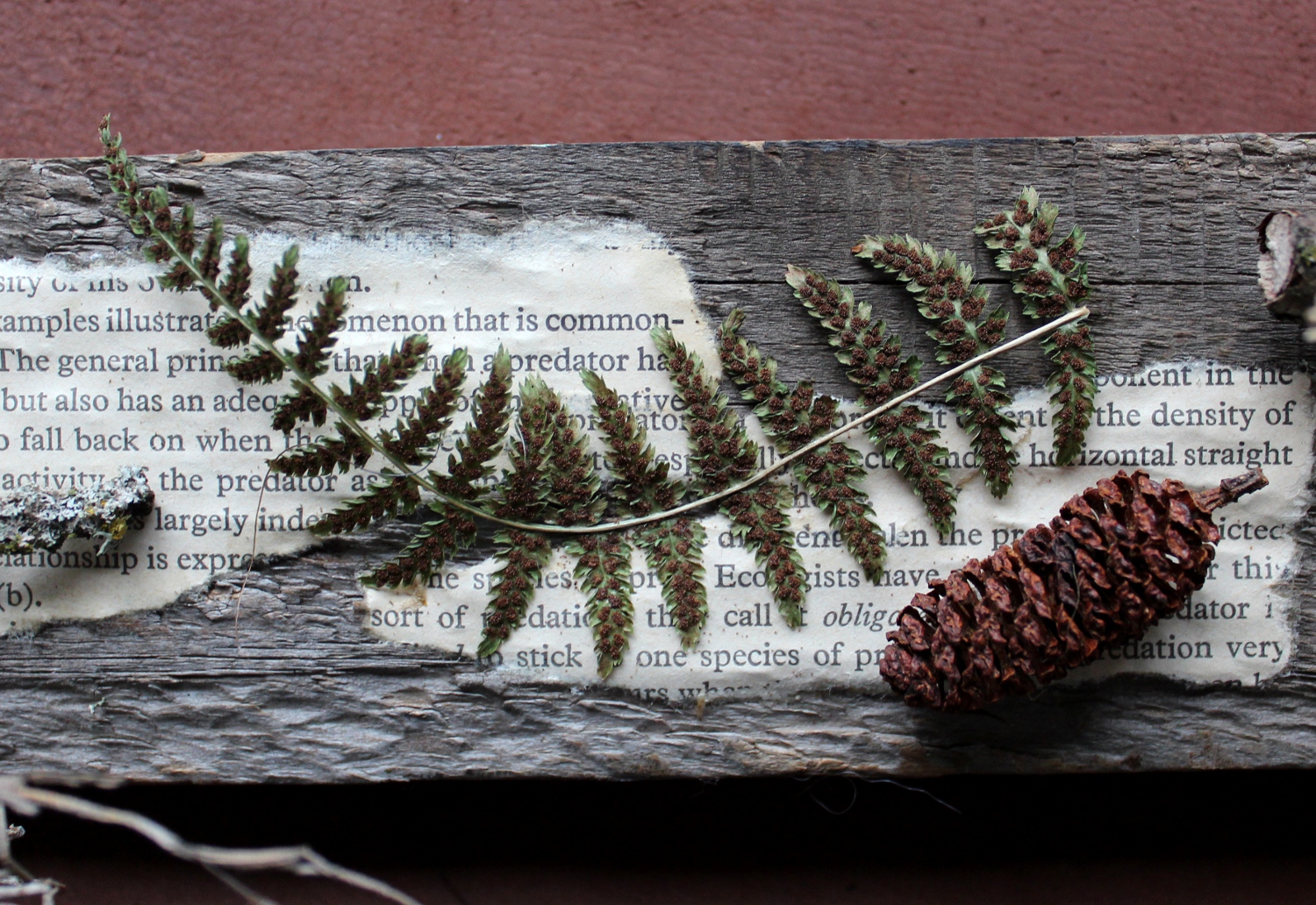 I’ve been aware of the environmental impact of my artwork for years. It’s not feasible–or desirable–for every artist to entirely switch to a completely guilt-free medium all at once. An established oil painter wouldn’t do very well to suddenly start making all of their art out of old bottle caps and twist ties. But we can look into ways to more organically shift our materials in an environmentally conscious direction.
I’ve been aware of the environmental impact of my artwork for years. It’s not feasible–or desirable–for every artist to entirely switch to a completely guilt-free medium all at once. An established oil painter wouldn’t do very well to suddenly start making all of their art out of old bottle caps and twist ties. But we can look into ways to more organically shift our materials in an environmentally conscious direction.
–Secondhand first (and local when new)
This is currently my most common solution to the environmental conundrum. Most of my acrylic paints are secondhand, either from SCRAP, local thrift stores, and even free boxes on Portland curbs. These sources often yield other treasures, like perfectly good paintbrushes, beads, yarn and related materials. And, as I mentioned earlier, I try to buy hides and bones secondhand as often as I’m able. I don’t remember the last time I actually bought something from Michael’s; the last new thing I bought was a couple of tubes of paint (acrylic and tempera) from the local family-owned art supply store around the corner from my apartment.
–Use it up, wear it out, make it do…
I throw very little away when it comes to my art. Tiny hide scraps and ends of thread end up as pillow stuffing. Old paint brushes get repurposed into assemblage materials. I don’t get rid of a tube of paint until I’ve squeezed the past tiny bit out of it. I also don’t buy things I don’t need. I have one pair of jewelry pliers I’ve been using for almost twenty years. While certain parts of my art might be a little easier if I owned an airbrush, I prefer to keep making the acrylics dance to my tune.
–…or do without
Sometimes I just say no, like with the taxidermy headdresses and resin jewelry. I already make awesome headdresses and beautiful jewelry without adding more to my plastics load. I don’t need to jump onto the next trendy-trend, especially if my conscience really isn’t okay with it.
–Finding alternatives
For the past few years I’ve been wanting to experiment with better alternatives to some of my materials. It’s only been recently I’ve started trying these new media, though. My most recent experiment has been testing tempera paint to see how it compares to acrylics in my usual creations. I’ve thought about making paints and glues from scratch (like these Earth Paints that my friend Autumn reminded me about recently), though I do have to be mindful of my time restrictions and the relatively small amount of paint/glue I use in one project. But it’s still an option on the table.
I also have to make sure the alternatives aren’t just as bad as–or worse than–what they’re replacing. I occasionally use hemp cord instead of yarn for necklace cords. Trouble is, it’s a lot harder to find it secondhand, which means I almost always have to buy it new. That means I’m contributing to the more immediate demand for this resource, which is often manufactured overseas and then shipped over here with a heavy environmental toll for the trip. And like other industrial crops, hemp is grown as a monocrop, which means miles upon miles of natural habitat chewed up for fields that only produce hemp, wildlife displaced and native plants exterminated. So in this case, at least, I figure secondhand yarn is the better option for me.
–Don’t take too much
It’s become en vogue in recent years to incorporate pine cones, seed pods, dried leaves and other such things into artwork, particularly assemblage and jewelry. Unfortunately, this can be devastating to a local habitat, especially if over-harvesting is done on a regular basis. I tend toward materials that aren’t in any danger of being extirpated; after a windy day I walk around my neighborhood and pick up sticks covered in lichens since they’re just going to end up mulched anyway. I leave nettles alone, though, because in Portland the numbers of red admiral butterflies have plummeted in recent years thanks to overharvesting of nettles for food by would-be back-to-nature fans. (Thanks to Rewild Portland for being honest and spreading the word about that unintended consequence!)
–Give back
Nothing is better than reducing your impact. But everything we do in this tech-heavy, resource-hungry culture has a negative effect on the environment, and so sometimes we can help through a sort of rebalancing. In addition to trying to be a more mindful artist, I give funds (and some volunteer time) to environmental nonprofits who can do more to make big changes than I can. I’m not a lobbyist, I don’t have the paperwork to go into parks and start planting native species, and I don’t have money to buy conservation easements. But I can at least funnel some of my income towards the people who do these things and more. And while I’m a busy self-employed person, I at least have enough schedule flexibility to do some volunteering now and then, whether it’s litter pickup or water testing.
When it comes to art and the earth, there are no quick and easy answers; using fake fur won’t automatically make you a more eco-friendly artist than I am. But if we keep having these conversations on what’s the best alternative for our own needs, and if we keep sharing information and resources, we can start shifting the attitudes that have led to our primary options being toxic and destructive, and move toward a more mindful and responsible way of creating our art.
Hiking Report: Rowena Plateau
2015 has been kind of a tough year for hiking for me. Since the start of the year, I’ve had events almost every single weekend, many out of town. And so I had to concentrate my time at home on work-related things, as well as keeping the apartment in some semblance of order. This meant I often ended up skipping my weekly hike–not a good idea, especially with the stress of travel!
However, April opened things up quite a bit; I have a lot of open time until midsummer, so I’m making the most of it. Earlier this month I went on a group hike south of Molalla with the good folks from Rewild Portland. I don’t do a lot of group hiking, just because I tend to go at my own pace, but it did end up being an excellent experience, with a lovely waterfall and a rubber boa and lots of good rewilding tips.
Last Friday I finally got to go on a solo hiking trip for the first time in ages. While I like hiking with other people, I’m much more comfortable on my own. It’s more refreshing, with only my own pace and agenda to attend to. And I like the quiet of solitude. Even though there were other hikers out on Rowena Plateau, we were far enough from each other to not feel crowded.
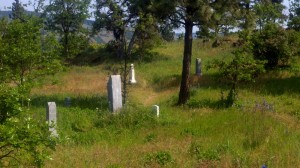 My first stop, though, was in nearby Mosier, OR. I love historical plaques, and the one that caught my eye as I drove through this little blip on the map said there was a pioneer cemetery up the hill. Sure enough, a three minute walk in the dust brought me to a little collection of mismatched stones from the late 1800s and early 1900s. It’s kind of a sad little place; there are more people recorded to have been buried there than there are stones, which means many go unmarked. And there’s a surprising number of younger people there, from babies to twenty-somethings. Not that this is surprising; it was a tougher time, with a lot less medical care and no vaccinations against common diseases. But the view is lovely, and it’s well-tended without being covered over in unnecessary green turf.
My first stop, though, was in nearby Mosier, OR. I love historical plaques, and the one that caught my eye as I drove through this little blip on the map said there was a pioneer cemetery up the hill. Sure enough, a three minute walk in the dust brought me to a little collection of mismatched stones from the late 1800s and early 1900s. It’s kind of a sad little place; there are more people recorded to have been buried there than there are stones, which means many go unmarked. And there’s a surprising number of younger people there, from babies to twenty-somethings. Not that this is surprising; it was a tougher time, with a lot less medical care and no vaccinations against common diseases. But the view is lovely, and it’s well-tended without being covered over in unnecessary green turf.
Rowena Plateau itself was a much more involved adventure. I’ve summited Tom McCall Point before; it’s a steep climb rife with poison oak, so I opted to go the easier, flatter route to enjoy the wildflowers. And they were out in force! I confess I don’t know my desert flowers so well; I can recognize arrowleaf balsamroot (a perennial favorite of mine), California poppy and bachelor’s button, and I met some desert parsley as well. But I enjoyed even those I couldn’t put a name to (and got some pictures for later identification.)
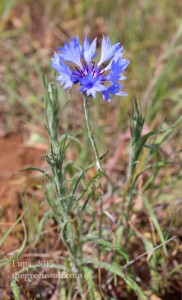 It’s also an excellent place for birdwatching. Turkey vultures cruise low over the plateau on thermals, and white-throated swifts nest on the cliffs below–they’re all over the place! There are a couple of ponds hidden along the trail where red-winged blackbirds ply their trade, the males making their characteristic “conk-er-jee!” territorial call. I even got my first confirmed sighting of a sharp-shinned hawk with the boldly striped tail. And a few ravens chortled at me as I walked by.
It’s also an excellent place for birdwatching. Turkey vultures cruise low over the plateau on thermals, and white-throated swifts nest on the cliffs below–they’re all over the place! There are a couple of ponds hidden along the trail where red-winged blackbirds ply their trade, the males making their characteristic “conk-er-jee!” territorial call. I even got my first confirmed sighting of a sharp-shinned hawk with the boldly striped tail. And a few ravens chortled at me as I walked by.
I find deserts to be deeply compelling; they feel wide and open, as though I could roam forever on their expanses. But they’re also an important reminder of how precious water is; just a few little ponds dotted the landscape, and the places where they trickled over into tiny streams were marked by explosions of yellow and white flowers. One can look out over the Columbia and be thirsty, for all that water is out of reach on top of the plateau. Let us then be thankful for tiny ponds and rivulets of flowers.
 After a few hours rambling around the plateau, I headed over to Mayer State Park to have a bit of communion with the Columbia. I sat on a gravel spit with my toes in the still-chilly water and watched a pair of Brewer’s blackbirds go about their business in the trees behind me. I noticed a beer can and a fishing lure on the ground near me, so once I was done soaking my feet I went back to the car and got out one of my SOLVE bags. In under an hour I had the bag half-full, mostly with picnic detritus and knots of old fishing line. (Once a SOLVE volunteer, always a SOLVE volunteer, I suppose!)
After a few hours rambling around the plateau, I headed over to Mayer State Park to have a bit of communion with the Columbia. I sat on a gravel spit with my toes in the still-chilly water and watched a pair of Brewer’s blackbirds go about their business in the trees behind me. I noticed a beer can and a fishing lure on the ground near me, so once I was done soaking my feet I went back to the car and got out one of my SOLVE bags. In under an hour I had the bag half-full, mostly with picnic detritus and knots of old fishing line. (Once a SOLVE volunteer, always a SOLVE volunteer, I suppose!)
I’ve been anxiously awaiting spring all winter, and this was an excellent “welcome home!”, to be sure. The next couple of months are fairly low-demand as far as out of town events go, so I fully intend to make the most of the time close to home. I had a nice conversation with the plant totem Arrowleaf Balsamroot; we spoke about how while it’s good for me to have a solid set of roots at home, even I need to sometimes stretch up toward the sun for special occasions. Plants don’t flower every single day of the year, but when they do it’s cause for celebration. In the same way I don’t spend every day on the trail, but when I do it’s something to be joyfully anticipated.
Spring Garden Time!
Last fall I got to the point where I was sick of my garden because of tomatoes.
See, I love making pizza sauce with fresh tomatoes. But last year I ended up planting way more tomato plants than I actually needed, and they all decided to send out a bumper crop in September–when I had a LOT of events happening. So I basically spent the month prepping for and being at events, and in between picking, prepping and canning pizza sauce. By the end of it, I didn’t want to see another tomato for a very long time, and I avoided the garden all winter.
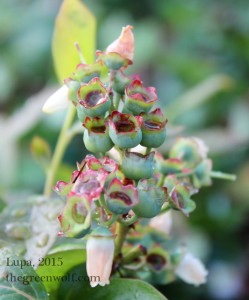 But spring has a way of bringing me around. One of the beautiful things about Portland is that our growing season is super-long. Even if you don’t do winter gardening, you can still start your spring planting in early to mid March, depending on what you plant. I ended up having to delay another month because March was just absolutely crazy-busy, and I simply didn’t have time to attend to the plot properly.
But spring has a way of bringing me around. One of the beautiful things about Portland is that our growing season is super-long. Even if you don’t do winter gardening, you can still start your spring planting in early to mid March, depending on what you plant. I ended up having to delay another month because March was just absolutely crazy-busy, and I simply didn’t have time to attend to the plot properly.
Of course, “attending to” was a lot more complicated than just throwing some seeds in the ground. Thanks to fall fertilization, winter rains, and no one wanting to go out in the cold weather, the weeds took over. My plot wasn’t so bad, but all community garden members are required to keep the paths around our plots weeded. I have a 10′ x 20′ plot with 40′ of path around it, and it had gotten pretty gnarly. So over the past few weeks the order of operations has been:
–Say hello to the two year old parsnips in the middle of the plot, and the kale I left to flower for the bees
–Tame the compost bin and take out the usable compost
–Spread the compost, along with some bone meal and minerals, on the soil and turn it under
–Weed the plot
–Get the first round of seeds in the plot
–Weed the paths and add new mulch (this took about five hours in and of itself)
–Put in another round of seeds
–Glare menacingly at any new weeds in the hopes that will slow their growth some
–Plant the raspberry bush I got as a thank you gift for renewing my Rewild Portland membership at their annual fundraiser
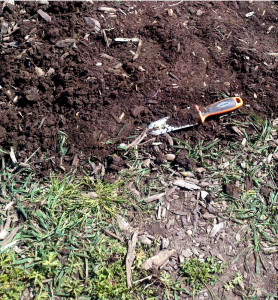
This year instead of going crazy over tomatoes, I decided squash would be the thing to do. It stores nicely and doesn’t need canning, and my household LOVES the stuff. I’ve been trying to cook more meatless meals, especially during summer and fall when the garden is producing nicely, and since the spaghetti squash I planted last year did pretty well and organic seeds were cheap, I’m hoping for a good crop this year. So I have several varieties planted and I’ll do another round in a couple of weeks to stagger things a bit and to see which seeds already planted actually germinate.
There’s also the usual roster of roots and leaves–beets, turnips, kale, spinach, and lettuce (not iceberg, mind you), and I cut up some old potatoes with sprouted eyes and got them in the ground. There will, of course, be peas in the pod, and I will allow myself to buy a few tomatoes once it warms up a bit more. In two months I expect everything to be green and flourishing, but for now it looks about like this:
It has been nice to rekindle my relationship with the garden again. I forgave it for throwing all the tomatoes at me at once, and I think I’ve been forgiven for letting the weeds get so tangled. So I’m looking forward to a nice year of cultivation and care, and long days in the sun in my garden plot.
Song For the Elements
I sing of water
Dripping in every pore
Sloshing through every vein
Pooling in each organ.
I drink deeply of the cool draught;
The tap carries Bull Run into my soul.
Rain peers out of my eyes,
And mist infuses every exhalation.
I carry the ocean in every cell.
Not an ocean, mind you.
The ocean.
The one that birthed all life,
The mother of all of us.
Every sip we take is us returning to Mama for a visit.
******************
I sing of earth
The rock that builds my bones
And teeth like storm-smoothed agate.
I have arches in my feet
And gullies at the corners of my eyes,
Through which flash floods rip at a moment’s notice.
I am mountains and hills in all the good places
And valleys so serene you’d swear it was paradise.
I have moss-soft flesh, and steel covered in velvet.
Long ago I was lava.
Tomorrow I’ll be dirt.
And in a week I’ll dive beneath the nearest plate
To build myself once again.
*******************
I sing of air
Nature’s own balloon
Filling in the spaces between things,
Because no one is truly empty.
I am the breath that cries
And laughs
And whispers fear in the night.
I am bubbles in the stomach
And molecules surfing the blood.
I convey memory and thought
Like ravens’ wings from synapse to synapse.
There is the low rolling tide of the lungs,
The approaching roar, the alveoli stand wide to receive
A flood of Os, satisfaction gained–
Death is averted once more.
*********************
I sing of fire
Fever’d skin and boiling blood
And the ache for a lover’s touch.
“Feed me”, I say,
And the furnace opens up for business.
No mere chemical reaction, this.
Only the most hellish and needful thing
That we scare each other with on Sunday morning–
And warm each other by of a Saturday night.
Every cell in my body is a flickering flame
A candle formed of fruits and meats and good fresh veggies.
The bread burns as brightly as the tallow.
Someday every one will wind down and become cinders,
But for now I burn brightly,
Fearful symmetry and all.
**************
Happy Earth Day, all. I hope you enjoyed the verse above. I also invite you to read and, if you agree with it, sign A Pagan Community Statement on the Environment. I was one of several people who worked on this statement over the past several months, getting it ready for today’s official unveiling.
Book Review: Cache: Creating Natural Economies
Cache: Creating Natural Economies
Spencer B. Beebe (author), Sam Beebe (photographer)
Ecotrust, 2010
252 pages
It’s a very good thing I don’t review books professionally any more. I have had this one (signed by Sam Beebe himself, even) for something like three years, and it just now made it to the top of the to-read stack. Not for lack of it being a good book, but like most nerds I have piles of books that I haven’t read yet and I’m chewing my way through as fast as I can (which isn’t very fast these days).
Thankfully, it’s still available, and well worth the wait. It fits right in with one of my pet hypotheses–that we’ve spent hundreds of years developing our current economic structure without taking the effects on nature into consideration, and that if we can’t overhaul the system entirely we can at least re-engineer it to be more ecologically friendly. This is not a book for people who want to change the whole thing entirely; it’s a book for those who are willing to take the current capitalistic system we have and subvert it for the powers of good.
The author, Spencer Beebe, has quite the environmental pedigree. He got his start with the current juggernaut of “let’s buy land to save it”, the Nature Conservancy, then co-founded Conservation International, which helps communities worldwide both gain economic freedom and protect their environment. He then took his work a step further by founding Ecotrust, which again works to create sustainable economies–in all senses of the term–but on a more local basis. (They’re right here in Portland, even!)
Cache is part autobiography, part challenge. It’s a fantastic behind-the-scenes of Beebe’s decades of work in the environmental movement, as well as some of the shortcomings of efforts he’s been involved with. But it’s also a story of his attempts to improve on those shortcomings, rather than simply rest on his laurels. The challenge is for the reader: the business professional is called to reconsider their company’s practices in relation to the environment; the layperson is invited to consider how our world could look differently if our money really was greener.
I do have to also mention Sam Beebe’s photography. You’d expect this book to be full of a few black and white photos and a bunch of graphs. Instead what we get are photos illustrating events and ideas, wrought in full color. Some of them are fairly official-looking–photos of Ecotrust’s Jean Vollum Natural Capital Center (during and after renovation), or people that the author worked with over the years. But then there are delightful surprises–four of the Beebe children on a tiny little raft floating down a stream no wider than my porch, with Mom keeping an eye out. Those of us who got our love of nature early on will recognize the importance of that sort of picture in this story.
To be honest, this book got me really excited. I have a very teeny tiny business, with just one person (me). But I am a part of the American economy, and the fact that someone out there is not just dreaming change but actively making it on a level that feels so far away from my ability to act just makes me heartened. I know that a lot of my left-leaning fellows want to see a complete overhaul of the system. But as long as that system is in place and stubbornly refusing to shapeshift into something else, I’m okay with people making use of it to better the world, and maybe even draining off a bit of the poison that’s infected it while they’re at it.
On Living My Paganism
This month marks nineteen years since I became pagan. In the intervening years I’ve been a generic Cunningham-flavored neopagan, spent several years as a Chaos magician particularly enamored of Carroll’s work, tried to form my years of experience and practice into a more formalized neoshamanic path, and found that what I really needed was just the opposite. These days, I still work with totems as I have since the beginning; I still have my work with skin spirits and hides and bones that I started in 1998. There are certain prayers, practices and personal acknowledgements that are largely unchanged from the early days.
But there are things I’ve left behind me as I’ve carried along my path. Rituals, for example. I no longer do much in the way of formal ritual, unless it’s a very special occasion like the opening ritual at Paganicon last month, where I was asked to help out. It’s not that I don’t acknowledge the value of a transformative experience. But I’ve historically called on these rites when I’ve felt the need to really shake things out of stagnation, and I haven’t felt stagnant in years. If you think of my life as a river, you can think of past creative blocks and frustrations as dams that needed to be overflowed and broken. More recently, I tend to wear away at the impediments–or I simply find a different course to take. My life is moving along just fine, even if it’s not always as quickly as I’d like. But I’ve learned the patience of the river in that.
My smaller, more personal rituals are integrated into everyday actions in much the same way. When I do my purification rituals on the hide and bone art I create, they’re worked into the actual creation process itself. A large part of these rites involves conversations with the skin spirits who once wore those remains, conversations that have long since become part and parcel of the creative process itself. I may appear to only be stitching and arranging and decorating, but each action is a phrase, each moment of concentration a chance to listen. There is far more going on than what is apparent from the surface.
And it’s like that in every part of my path. The older I get, the more I recognize the sacred in everything. Nature is what is most sacred to me, and everything is of nature. We humans have taken things like tool-using and nest-building to unprecedented degrees, and we’ve had a really detrimental effect on the rest of the planet at the same time. But we are still of nature; even our creations are of nature, no matter how we’ve altered them from their original forms. So I must acknowledge the sacred in nuclear waste as much as I acknowledge the sacred in a field of beargrass on the flanks of Mt. Hood.
That doesn’t mean I can blithely ignore the effects of nuclear waste, or fracking, or climate change. Just the opposite. We feel compelled to preserve, protect and be engaged in what we consider sacred. This calls me to a path where I am more consciously aware of every moment, every action, not just as an exercise in self-centeredness, but as a sharp reminder of every single thread that “hitches me to everything else in the Universe” (to borrow a phrase from John Muir). This awareness shapes my choices; it compels me to walk my talk.
When I did formal rituals before, a lot of my purpose was to find connection to the sacred. Now I recognize that I am immersed in the sacred at all times, and my goal is not to find the sacred but to remind myself of it, both in thought and action. This state of constant connection is what I was trying to find for so many years. It was what I sought when I stood with athame in hand working early rituals right out of Cunningham’s Wicca: A Guide for the Solitary Practitioner. It was there when I tried to expand my consciousness through Chaotic rites. It was there when I wanted to feel the same devotional joy that others around me did with their daily practices and many altars. And I finally found the first thread of it when I let all of that fall away and simply immersed myself in the wildness I had been seeking all along.
It’s not that the practices I’d done before were useless. All the years of meditation and ritual prepared me for this in-the-moment awareness, due in no small part to how they taught me to focus more keenly. Now I can find my connection to sacred even amid distractions, in the most urban of areas, and I set aside distractions with the same skills I learned when casting my first circles. It’s just that now I don’t need the circle casting to find that focus.
Nor do I feel a need to mark particular times of year as more special than the rest. The eight Sabbats are a nice system for reminding a person of the cycles of nature; they’re just close enough to each other to be regular celebrations, but far enough apart that there are significant changes that occur between them. I could mark times that are notable to me–the first rain after the late summer hot spell, or the time when the birds migrate away in spring, or when the strawberries bloom a second time in the year. But there’s always something notable going on in nature. I’d rather my path be in a constant state of celebration rather than picking and choosing which natural events to honor over others.
One might think it’s a lonely, boring path with no parties for special occasions or magical workings. It’s a quieter path, to be sure, but not lonely, and never boring. And I find the rites and such to be distractions at this point, keeping me away from the quiet, constant communion with the sacred that I’m trying to find in every moment, whether curled up in a coffee shop with my laptop, racing around attending to details at an event I’m vending, or looking up at the stars over my campsite as I backpack alone in the wilderness.
Maybe someday that’ll change again. Perhaps I’ll feel called to perform formal rites again, either for myself or for others. That’s the glorious thing about this path I’ve walked for almost two decades–it’s constantly shifting and evolving, flowing like the river through a twisting, turning course.
The Tarot of Bones IndieGoGo is Live!!!
AAAAAAAAAND HERE IT IS!!!!! THE TAROT OF BONES INDIEGOGO CAMPAIGN IS LIVE!!!!!!
Here’s your chance to get THE best price for the Tarot of Bones deck and book set (due out Summer 2016), AND get lots of neat perks! What kinds of perks?
- A handmade (by me!) leather pouch for your Tarot of Bones deck
- Copies of my other books on paganism and nature spirituality
- Prints of select cards
- Original assemblage pieces used in the creation of the Tarot of Bones
- A thank you in the Tarot of Bones book and website
- Other perks to be revealed if we meet the goal of $5,000 and get into stretch goal territory
Plus you’ll be helping me acquire the rest of the materials I need to complete the card art as well as offset some of the other costs. While this isn’t my only source of funding, the campaign will help me stick to my production schedule for the project.
What is the Tarot of Bones? It is a natural history-themed divination set I am creating. I’m making 78 permanent assemblage pieces, one for each of the cards, featuring animal bones and other natural and reclaimed materials. These assemblages will then be photographed for the card art, and the deck will be released with a full-length companion book (not just the little white booklet). You can find out more about it and see photos of completed assemblage pieces at the official Tarot of Bones website.
And if you’re in the vicinity of Portland, OR, don’t forget about the Tarot of Bones party at Paxton Gate this Friday evening from 6pm – 8pm! You can see some of the assemblages on display, listen to me talk about the project, and sign up to back the IndieGoGo campaign! More information can be found here.
For just $5 you can help make the Tarot of Bones a reality! And even if you can’t contribute, please reblog/reweet/share the IndieGoGo campaign so others have the opportunity to be a part of it all! And many, many thanks for your support and help 🙂

